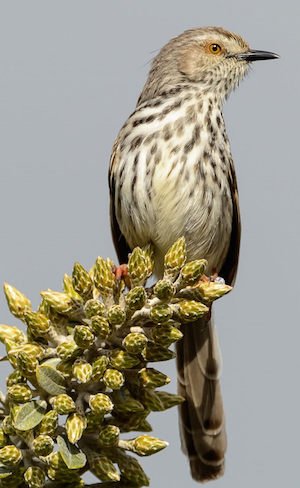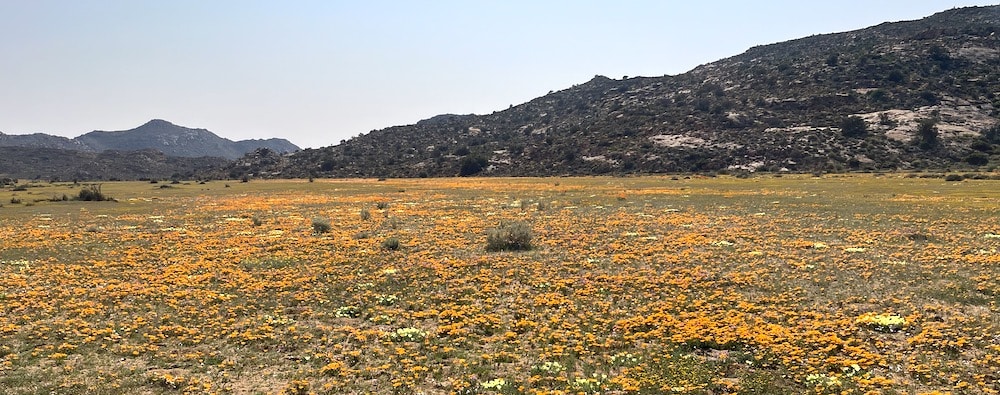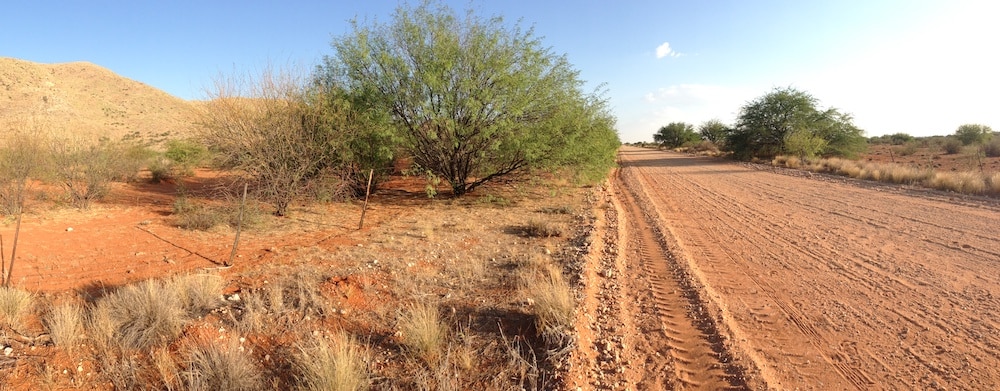Northern Cape

The Northern Cape has a shoreline in the west on the South Atlantic Ocean and is bordered by Namibia to the northwest, Botswana to the north and the provinces of North West to the northeast, the Free State to the east, Eastern Cape to the southeast and Western Cape to the south and southwest. It is the largest South African province covering more than 370,000 km² but its most sparsely populated with just 1.5 million inhabitants. This means distances between towns are enormous. Its capital is Kimberley. It includes the Kalahari Gemsbok National Park, part of the Kgalagadi Transfrontier Park and an international park shared with Botswana. It also includes the Augrabies Falls and the diamond mining regions in Kimberley and Alexander Bay. The Namaqualand region in the west. The southern towns of De Aar and Colesberg found within the Great Karoo are major transport nodes between Johannesburg, Cape Town and Gqeberha.
The Orange River flows through the province, forming the borders with the Free State in the southeast and with Namibia to the northwest and its tributaries also flow within the province such as the Vaal. Harts River and Riet River. Several other rivers drain parts of the province. The river is also used to irrigate the many vineyards in the arid region near Upington. The province is dominated by the Karoo Basin. However, the south and southeast of the province is high-lying, 1,200–1,900 metres in the Roggeveld and Nuweveld districts. The west coast is dominated by the Namaqualand region, famous for its spring flowers. This area is hilly to mountainous and the central areas are generally flat with interspersed salt pans. Kimberlite intrusions punctuate the Karoo rocks, giving the province its most precious natural resource, diamonds with Kimberley having the most famous diamond mine in the world. Mining is the provinces principal economic activity followed by agriculture, which is mostly sheep farming and viticulture. The north is primarily Kalahari Desert, characterised by parallel red sand dunes and acacia tree dry savanna.
Northern Cape is mostly arid to semiarid, few areas in the province receive more than 400 mm of rainfall annually and the average annual rainfall over the province is half that. Rainfall generally increases from west to east. The west experiences most rainfall in winter, while the east receives most of its moisture from late summer thunderstorms. Many areas experience extreme heat, with the hottest temperatures in South Africa measured along the Namibian border. Summers maximums are generally 30 °C or higher, sometimes reach more than 40 °C. Winters are usually frosty and clear, with southern areas sometimes becoming bitterly cold, such as Sutherland, which often receives snow and temperatures occasionally drop below the −10 °C mark.

Namaqualand ©Chris Lotz
Birding Northern Cape
Western South Africa, comprising the Western and Northern Cape Provinces, is one of the world’s greatest biodiversity hotspots and is legendary among international and local birders alike for the remarkable variety of birds that are found here and nowhere else. It is an indispensable destination for the eco-tourist and there are no other areas in Africa that offer such a high level of endemism in such a uniquely accessible setting. A staggering 47 of South Africa’s 58 endemic and near-endemic bird species occur here, as well as 76% of southern Africa’s 181. New innovations to assist the eco-traveller include a birding site guide that covers the region, and the Cape Birding Route that links the up-to-date birding information with practical routes to follow and accommodation options.
Local and international bird-watchers are inevitably drawn to the region by the tourism gem of Cape Town, the capital of the adjacent Western Cape Province, and by the region’s scenic and cultural diversity, well-developed infrastructure, high standard of accommodation, and excellent network of national parks and provincial and private nature reserves. More than 600 bird species have been recorded in the Western and Northern Cape Provinces, and a two-week trip could expect to yield in excess of 300 species. Indeed, over 220 species have even been seen around Cape Town in a single day! Although the sheer diversity of southern Africa’s more tropical eastern region is inevitably higher, most of these species have wide distributions and extend over much of eastern Africa. The west, by contrast, is rich in species largely restricted to this region, making the Western and Northern Cape Provinces an essential destination in both global and local terms.

Upington ©Dylan Vasapolli
The top 10 Species in the Northern Cape are said to be Ludwig’s Bustard, Red Lark, Burchell’s Sandgrouse, Black-eared Finchlark, Sclater’s Lark, Barlow’s Lark, Burchell’s Courser, Cape Eagle Owl, Cinnamon-breasted Warbler and Dusky Sunbird.
The Northern Cape Province has a wide diversity of birding habitats including the Arid Kalahari Savanna, Succulent and Nama Karoo (the majority of the Karoo lies in the Northern Cape) and wetlands and coastal habitats. Perhaps Africa’s most characteristic vegetation type, Arid Savanna forms an intermediate between grassland and woodland and occupies the famed Kalahari region. Rainfall is in the form of summer thunderstorms that support good grass cover below a varying density of thorn-trees. Although savannah supports a diverse bird community, and the characteristically arid savannah in this region holds endemics such as Kalahari Robin, Ashy Tit, Marico Flycatcher and Crimson-breasted Shrike. Raptors abound.
The Karoo is a vast semi-desert area that is divided into two botanically very different regions and dominates the arid western half of South Africa. It forms part of the most ancient desert system in the world, and is an open area of stony plains, scattered with small shrubs, punctuated by low dunes and hills (koppies), and is very sparsely inhabited. The Succulent Karoo Biome is characterized by small succulent plants, supported by low but predictable winter rainfall, whereas the summer-rainfall Nama Karoo Biome is dominated by grasses and low, woody shrubs. The Succulent Karoo Biome is one of Africa’s biodiversity hotspots, and has the highest diversity of succulent plant species in the world. Despite these fundamental climatic and vegetation differences, most Karoo bird specials occur in both biomes. Karoo endemics and near-endemics include Karoo Korhaan, Ludwig’s Bustard, Red, Barlow’s, Karoo Long-billed, Stark’s and Sclater’s Larks, Black-eared Finchlark, Karoo and Tractrac Chats, Karoo Eremomela, Cinnamon-breasted Warbler, Namaqua Warbler, Pale-winged Starling and Black-headed Canary.
The productive Benguela Current surges up the Atlantic coast, bringing chilly, nutrient-rich waters from Antarctica, while the warmer Agulhas Current moves down the east coast of Africa from more tropical climes. The birds endemic or near-endemic to the plentiful waters of the Benguela Current of southern Africa’s west coast are African Penguin, Cape Gannet (breeding endemic only); Cape, Bank and Crowned Cormorants, African Black Oystercatcher, Hartlaub’s and Cape Gulls and Damara Tern (breeding endemic only).
Combined with a visit to the Western Cape Province, the Northern Cape provides the best chance for arid country specials. Foreign birders visiting the Northern Cape Province will need a week based in the region. Birding is excellent throughout the year and the rains fall in summer.
-
Bushmanland
InformationBrandvlei area: Open semi-desert plains. Sclater's and Red Larks, Black-eared Finchlark, Burchell's Courser.Pofadder area: Open plains, mountains, dunes. Red Lark, Cinnamon-breasted Warbler. Augrabies Falls National Park: Cliffs, plains and riverine. Pale-winged Starling, Cinnamon-breasted Warbler. -
Die Bos Nature Reserve - Prieska
Satellite ViewA ±62ha reserve on the banks of the mighty Orange River. African Black Duck is seen often with Cape Francolin, both Ashy and Grey Tit, Pririt Batis, African Fish-eagle, Lesser Honeyguide and Pearlspotted Owlet at its most southern limit -
Kalahari
InformationSatellite View- Kalahari Gemsbok National Park- Kgalagadi Transfrontier Park. Excellent for arid savanna species, raptors and large mammals such as Lion, Cheetah and Gemsbok. Burchell`s Sandgrouse at waterholes. -
Kamieskroon
InformationSatellite ViewGranite outcrops with sparse vegetation. Grey-backed-, Cloud- and Zitting Cisticola occurs here with Karoo Long-billed Lark, Pale Chanting Goshawk and the nomadic Black-headed Canary seen on regular intervals. -
Namaqualand
InformationSatellite ViewPort Nolloth: Coastal dune and pan. Barlow's Lark, Cape Long-billed Lark, Damara TernGoegap Nature Reserve in Springbok: Karoo Eremomela, Cape Eagle Owl -
Spitskop Nature Reserve
WebpageSatellite ViewEn-route to Kgaligadi National Park outside Upington. Namaqua Warbler, Ashy Tit, Fawn-coloured Lark, Spike-heeled Lark, Pygmy Falcon and Shorttoed Rock-thrush occurs in this jewel. -
Van Wyk's Vlei
InformationSatellite ViewSemi-desert area with flocks of Black-eared Sparrowlarks, the uncommon and nomadic Sclater's Lark and the highly habitat-specialised Red Lark.
-
Claire Spottiswoode & Callan Cohen
Percy FitzPatrick Institute of African Ornithology, Cape Town
https://birdingafrica.com -
Supplementary Information - Johan van Tonder
-
Number of bird species: 615
-
Avibase - The World Bird Database
PDF ChecklistThis checklist includes all bird species found in Northern Cape , based on the best information available at this time. It is based on a wide variety of sources that I collated over many years. I am pleased to offer these checklists as a service to birdwatchers.
-
Cape Bird Club
WebsiteWe’d love you to get involved in one of our many initiatives. You can just come along to see what we do or get involved in a more permanent capacity. If conservation is an interest of yours or you just want to help casually get in touch.
-
GP Tswalu Kalahari Reserve
WebsiteSatellite ViewTswalu is situated in an enormous private game reserve in the Kalahari Desert in the Northern Cape. Tswalu features harsh thorn bush, rolling grass plains, stark mountains and immense African skies… -
NP Meerkat
InformationSatellite ViewAfter declaring the park, a number of steps were taken to rehabilitate the land, including the removal of livestock, fences and copses of alien mesquite, this saw an increase in wildlife numbers. -
NP Richtersveld
InformationSatellite ViewRichtersveld National Park is the South-African part of the ǀAi-ǀAis/Richtersveld Transfrontier Park. -
NP Augrabies Falls
InformationSatellite ViewThe Khoi people call it Akoerabis, the place of the Great Noise, referring to the Orange River thundering its way downwards for 60 metres in a spectacular waterfall. The 88 000 hectares on both sides of the Orange River provide sanctaury to a diversity of wildlife. When the tree flowers in the winter flocks of birds are attracted to their copious nectar, and baboons can be seen tearing the flowers apart to get the sweet liquor. -
NP Mokala
InformationSatellite ViewThe size of the park is 26,485 hectares. Mokala is the Setswana name for the magnificent camel thorn, a tree species typical of the arid western interior and common in the area. There is currently 70 km of accessible roads in the national park. A bird list is available at reception. In summer, the best time to go birding in Mokala National Park is at sunrise, particularly between 07h30 and 09h00. The level of endemism at Mokala is high. The Kalahari sandveld habitats hold more bird species than the rocky areas, especially during times of higher rainfall. The endemic black-chested prinia thrives in the arid conditions of the park. Chestnut-vented warblers are attracted to the lawns surrounding the lodges. A fairly tame pair of Cape buntings frequent Mosu Lodge, using the buildings as an artificial nest structure, while greater striped swallows nest beneath the eaves of the restaurant's thatched roof. -
NP Namaqua
InformationSatellite ViewThe park is part of Namaqualand, an area covering 55,000 km2 located within the semi-desert Succulent Karoo biome. This biome is a biodiversity hotspot with the largest concentration of succulent plants in the world. -
NP Tankwa Karoo
InformationSatellite ViewTankwa-Karoo National Park & Northern Cape Nature and Game Reserves: The 80,000 hectare Tankwa Karoo National Park, proclaimed in 1986 and still in a development stage, is at present in a veld recovery phase and it will be some time before the original vegetation re-establishes itself. Even so, after the occasional shower, the park erupts into a dazzling display of flowering succulents… -
NR Kamfers Dam
InformationSatellite ViewThe area of water at the dam has become a major breeding site for lesser flamingos since the construction of an artificial island. The dam and surrounding 380ha wetland area are designated as a conservation zone. -
NR Laohu Valley
InformationSatellite ViewThe Laohu Valley Reserve (LVR) is a nature reserve located near Philippolis in the Free State and near Vanderkloof Dam in the Northern Cape of South Africa.It is a roughly 350-square-kilometre private reserve. -
NR Spitskop
Facebook PageSatellite ViewThe reserve is situated 13 km north of Upington and measures 5,641 hectares and derives its name from a prominent steep rocky hill close to the entrance. -
NR Witsand
InformationSatellite ViewWitsand Nature Reserve is located in Northern Cape, South Africa, and covers 3,500 hectares. The reserve is 80 km southwest of Postmasburg and 59 km northeast of Groblershoop. The reserve is dominated by sand dunes on a plateau around 1,200 m above sea level. Singing sand can be found here, a phenomenon in which during the dry summer months, a roar can be heard while walking over the sands. -
TP Kgalagadi Transfrontier Park
InformationSatellite ViewWhere the red dunes and scrub fade into infinity and herds of gemsbok, springbok, eland and blue wildebeest follow the seasons, where imposing camel thorn trees provide shade for huge black-maned lions and vantage points for leopard and many raptors… this is the Kgalagadi Transfrontier Park. -
TP Richtersveld
InformationSatellite ViewConjure up a desolate and forbidding landscape, seemingly devoid of life, except for some people dotting along the horizon. Make a startling discovery upon closer inspection when the mirage dissolves into the human-like half-men (half person) and the harsh environment prove to be a treasure-chest containing the world’s richest desert flora…
-
Birding Africa
Tour OperatorBirding Africa is run by three Capetonian birders and naturalists, Callan Cohen, Claire Spottiswoode and Peter Ryan, all based at the University of Cape Town`s Percy FitzPatrick Institute of African Ornithology. Callan and Claire are postgraduate research students, and have recently published an new birding site guide to Cape Town and beyond: Essential Birding - Western South Africa. Peter is a lecturer and researcher, and the author of numerous publications, most recently a new field guide to the birds of Afrotropics. -
Birding Ecotours
Tour OperatorSouth Africa is one of the best value destinations on the entire continent. The outstanding infrastructure, great accommodation, excellent food, wonderful South African hospitality, spectacular and varied scenery, and the presence of Africa's big and small mammals makes it one of the most pleasant countries in the world to bird in... -
Brian's Birding Tours
Tour OperatorSpecialises in personalised Birdwatching tours in the Western and Northern Cape. We do Birding Day Trips and Overnight Tours from Cape Town, as far as the Kalahari National Park. We offer customised Birding, tailored to your birding wishes… -
Rockjumper
Tour OperatorThere are 39 tours available in South Africa...
-
2017 [11 November] - Jason Boyce
PDF ReportThis tour was a private photography trip for two clients with a particular interest in the smaller mammals of South Africa. However, the larger mammals and birds were also thoroughly enjoyed! -
2022 [08 August] - Chris Lotz & Dominic Rollinson - Birds & Mammals
PDF ReportThis was a private, custom trip focused on finding Tim some tough and/or localized birds and mammals in remote parts of South Africa. In addition to seeking these tricky species, we also headed into the Richtersveld National Park for spectacular scenery and plants. Since that brought us right to the border, we also decided to cross the Orange River into Namibia to see the Fish River Canyon. Here we were glad to see some of the avian
-
Tswalu Private Desert Reserve
AccommodationNine spacious, fully air-conditioned thatch and stone suites surround the main lodge - Over 40 different species of animals and over 250 species of birds may be seen when exploring the vast landscape by open sided game vehicles, on horseback or on a game walking trail.

